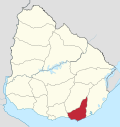Piriápolis
Piriápolis | |
|---|---|
City & Municipality | |
 | |
| Coordinates: 34°54′0″S 55°17′0″W / 34.90000°S 55.28333°W | |
| Country | |
| Department | |
| Founded | 1890 |
| Founded by | Francisco Piria |
| Area | |
| • Total | 25 km2 (10 sq mi) |
| Population (2011 Census) | |
| • Total | 8,830 |
| Time zone | UTC -3 |
| Postal code | 20200 |
| Dial plan | +598 443 (+5 digits) |
| Climate | Cfa |
Piriápolis is a city in the Maldonado Department of Uruguay. It is an important summer resort in the country, predating the larger and better known resort town of Punta del Este. Because it is mainly used as a resort, it has a relatively small permanent population for a city of its size.
Piriápolis is also the name of the municipality to which the city belongs. It includes the following zones: Piriápolis, Playa Grande, Playa Hermosa, Playa Verde, Punta Colorada, San Francisco, Punta Negra, Sauce de Portezuelo, Ocean Park, Barra de Portezuelo, La Capuera, Puntas de la Sierra, La Falda, Miramar, Colonia V. Suárez, Sierras del Tirol.
Location
It is located on the coast of Río de la Plata, on Route 10 and its intersection with Route 37. It is about 100 kilometres (62 mi) east of the national capital, Montevideo (via Ruta Interbalnearia and Route 37).
History
Piriápolis was founded on 5 November 1890[1] by Francisco Piria. Its initial name was El Balneario del Porvenir (the Resort of the Future). In 1890, Piria had bought a very big stretch of land, including the hills Cerro Pan de Azúcar, Cerro del Inglés and Cerro del Toro, all the way south to the beach. In 1897 he finished the construction of his personal residence, Piria´s Castle, in 1905 the construction of "Hotel Piriápolis", today known as "Colonia Escolar de Vacaciones", in 1910 he constructed the coastal avenue Rambla de los Argentinos, and in 1912 he started selling the first building lots. In 1913 he established a scenic steam train line joining the (under construction) Port of Piriápolis with the Cerro Pan de Azúcar. The construction of the port finished in 1916. From 1920 to 1930 he constructed the Argentino Hotel, one of the biggest hotels of South America of the times. When Piria died in 1933, his natural and legal children started fighting each other over the inheritance.
On 10 September 1937, the status of the populated centre was elevated to "Pueblo" (village) by the Act of Ley Nº 9.687.[2] On 21 June 1960 its status was further elevated to "Ciudad" (city) by the Act of Ley Nº 12.736.[3]
Population
In 2011 Piriápolis had a population of 8,830 permanent inhabitants[4] and 8,489 dwellings.[5] According to the Intendencia Departamental de Maldonado, the municipality of Piriápolis has a population of 14,000.[6]

| Year | Population | Dwellings |
|---|---|---|
| 1963 | 4,546 | 2,620 |
| 1975 | 5,240 | 3,661 |
| 1985 | 5,878 | 4,289 |
| 1996 | 7,570 | 5,640 |
| 2004 | 7,899 | 7,123 |
| 2011 | 8,830 | 8,489 |
Source: Instituto Nacional de Estadística de Uruguay[1][7]
Places of interest





The city is centered on the Rambla de los Argentinos, a waterfront promenade. With a tourism-centered economy, Piriápolis has opulent hotels, large casinos, an active nightlife scene, and public parks. The Templo de San Antonio, situated atop one of the hills surrounding the city, can be reached by chair lift and offers a panoramic view of the coast. For more adventurous travelers, Uruguay's third-highest point, the Cerro Pan de Azúcar, can be found 10 km outside of town. The peak presents a challenging climb as well as a nature reserve. Boat tours and saltwater fishing are available at the Piriápolis port.
The Castle of Piria, near Piriápolis, is open to the public. The poet Julio Herrera y Reissig resided at the Castle for a period.
Places of worship
In fiction
- The Uruguayan film Whisky is partly set in Piriápolis.
- Juan Grompone's mystery novel Asesinato en el hotel de baños is set in Piriápolis.
See also
References
- ^ a b "Statistics of urban localities (1963–2004)" (PDF). INE. 2012. Retrieved 8 September 2012.
- ^ "Ley Nº 9.687". República Oriental del Uruguay, Poder Legislativo. 1937. Retrieved 8 September 2012.
- ^ "Ley Nº 12.736". República Oriental del Uruguay, Poder Legislativo. 1960. Retrieved 8 September 2012.
- ^ "Censos 2011 Cuadros Maldonado". INE. 2012. Retrieved 25 August 2012.
- ^ "Censos 2011 Maldonado". INE. 2012. Retrieved 25 August 2012.
- ^ "Presupuesto-2011-2015". Intendencia Departamnetal de Maldonado. 2012. Archived from the original on 24 April 2011. Retrieved 11 September 2012.
{{cite web}}: Unknown parameter|deadurl=ignored (|url-status=suggested) (help) - ^ "1963–1996 Statistics / P" (DOC). Instituto Nacional de Estadística de Uruguay. 2004. Retrieved 26 July 2011.
{{cite web}}: Italic or bold markup not allowed in:|publisher=(help)
External links
- Portal de Piriápolis
- Information on Piriápolis, Maldonado Template:Es icon
- Piriápolis, in Maldonado Hall Town official website Template:Es icon
- Tourist Information about Piriápolis Template:Es icon Template:En icon
- www.piriapolis.com
- Article on Piriápolis, Official Portal of the Uruguayan Government
- INE map of Piriápolis, Punta Colorada and Punta Negra
- Hotels in Piriápolis


